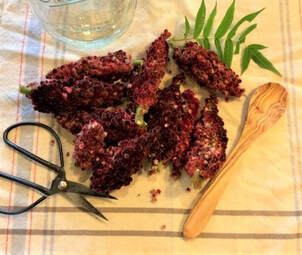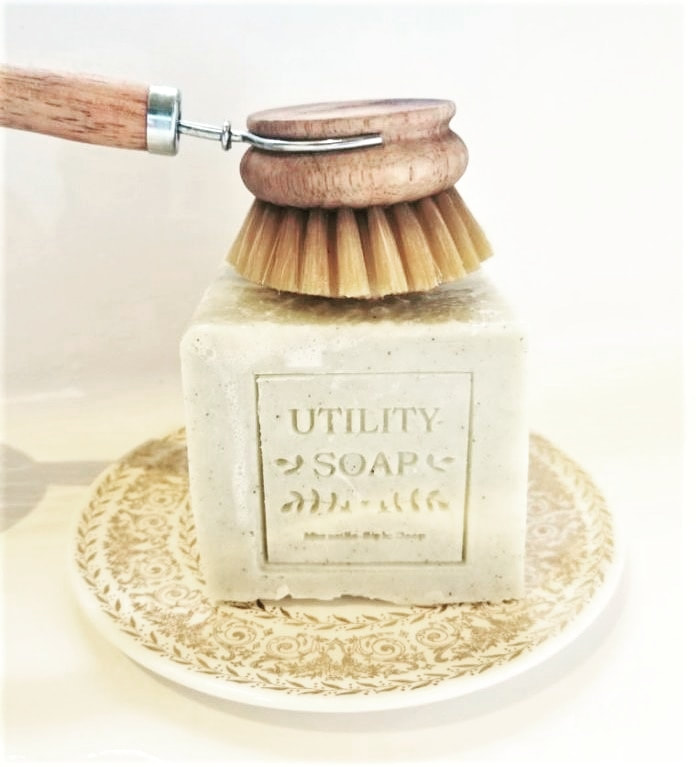Poor Staghorn Sumac gets the bad-rap for naught! Many, many people believe all types of Sumac to be poisonous, but that's far from true! Rhus-Family Sumac has been used medicinally & culinarily for centuries. It is packed with Vitamin C, making it a strong antioxidant, but it is also anti-inflammatory, a diuretic, antiseptic & astringent! Sumac is truly valuable as an easily foraged source of Vitamin C in the northeast USA. Not just medicine & food--Sumac is also excellent for dying yarns & fabrics, with no need of a mordant! Sumac has a unique, tart flavor similar to lemon. One of the simplest ways to use it is to make Sumac Lemonade [recipe to follow] with fresh bobs, but it can also be dried & used as a spice. Sumac has been used for centuries in the Middle East & Mediterranean as a flavoring & is what gives za’atar blends their zing! I'll walk you through preparing your sumac & using it both ways!
Late August through September is the best time for foraging them--on into October if it has been dry. The bobs may feel a bit sticky to the touch. People will often squeeze bobs, then lick their fingers to check for tartness & ripeness! [hint: if it's bitter, it's not ripe yet!] The strange red fuzz on the outsides of each seed is what provides the flavor & nutrients--that is what you're after! Clip whole bobs off at the base & bring them home to prepare. Look for bright red bobs, avoiding rusty brown ones or bobs with mold. As always, be sure to harvest only from trees that have not been sprayed with insecticides & that are far from heavily traveled roads/highways. Sumac is best harvested after a couple of days without rain, as the water washes much of the flavor out.
A couple cleaned handfuls are all you need to brew up some Sumac lemonade. The ‘berries’ contain a lot of tannins, so they are best cold brewed as hot water will bring on the bitter notes. We are ready to make our ‘lemonade!’ SPARKLING SUMAC LEMONADE 1 cup sumac berries [cleaned from about 2 clusters] 4 cups cold water Super-fine sugar, honey, or plain simple syrup to taste Sparkling water
Sumac provides tartness & vitamins, but not sweetness on its own, so the next step is to sweeten your batch to your taste. I find adding plain simple syrup the easiest way to achieve this. Your Sumac Lemonade base can be stored in the fridge like this for up to 3 days. The base is great on ice on its own or used in cocktails! [plays nicely with vodka & gin] I like to ‘up’ the refreshing factor by topping my glass of lemonade off with a splash of sparkling water: Simply add ice to a pitcher or glass & fill ¾ with Sumac lemonade, then float some sparkling water on top--Voila! Sparkling Sumac Lemonade!
I break up & clean my sumac as described above, then spread the seeds out to dry on screens. Many people use dehydrators on ‘fan’ setting with no heat or even heat lamps to dry their sumac. Any area with good circulation will do. After about a week, the seeds are usually dry enough to grind. The red fibers are our goal-- running the dried seeds through a blender or spice mill, then sifting them through a flour-sifter is the easiest way I have found to separate the red fruit fibers from the seeds & any small bits of stem left. Now you have your own Sumac Spice! Dried & ground, your sumac will keep for up to a year. It's wonderful on chicken, fish & eggs. Use it on its own or make your own blends, such as za’atar. Simple Za’atar Blend It is as simple as that! DELICIOUS! Try it mixed into labneh or brush some pita with olive oil, sprinkle some on top, & broil for a minute or 2 -- Heaven! I have heard some people like to add oregano or marjoram to their mix as well -- play around with it & find what works best for you.
Your taste buds will thank you for it! That is all for this week-- I hope this post has helped to shake off some of Sumac’s bad reputation! Sumac is a perfect example of a truly misunderstood plant -- Delicious & nutritious foods & medicines are growing all around us! Don’t forget to #StopAndEatTheFlowers
1 Comment
jacqueline
11/14/2021 03:09:18 pm
Thank you for the well-written article. I’m trying to learn about and deconstruct the usual ingredients in za’atar to see why the blends I’ve been served taste moldy to me. Now I know more about Sumac which I love as a plant and for it’s tart flavored fruits.
Reply
Leave a Reply. |
Categories
All
Archives
May 2024
|
|
|
'Beautiful & responsible' Online: Ship or Pick-Up
Store Hours: Wednesday 11 am - 4 pm Thursday 11 am - 4 pm Saturday 11 am - 3 pm Damariscotta Farmers Market: May 17 - Oct 25 2024 |
207-563-6256 [email protected] © Du Jardin 2019
In the Smitten Barn - 2 Hodgdon Street - Damariscotta, Maine 04543






















